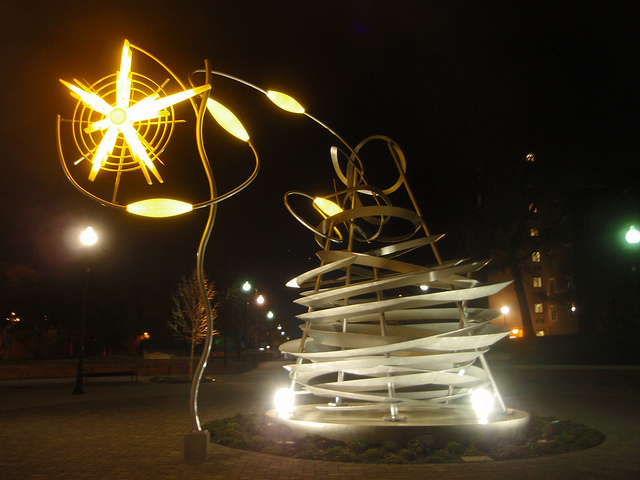
By Julia Cooke
If we were to climb inside of Alice Aycock’s drawings, we could catch and manufacture ghosts or ride short roller-coasters to nowhere. We might find respite from the world in dark underground tunnels or perch, Rapunzel-like and meditative, on platforms atop wooden skyscrapers. We could choose between dwellings in linked castles clad with either fence posts or tiny nonsensical turrets or select shantytowns of clustered huts. All these are options at her new retrospective.
“I have these—I used to say, like Stalin—five-year plans… in which I move through ideas, and then I move through another set of ideas… ”
Aycock is best known for her work as a sculptor. Her last retrospective, in 1990, was of her large-scale objects at Storm King Art Center. You may have seen her public artworks at places like JFK International Airport and the East River Park Pavilion. She calls many of these pieces “non-functional architecture,” and the experience of them is wholly unlike that of her works on paper. Suppose you were scrambling through “Simple Network of Underground Wells and Tunnels” (1975), which is as straightforward as its title: you would crawl through tunnels, feeling the damp of the earth, toward the well that throws light down its shaft. But standing before drawings of the structure at “Some Stories Are Worth Repeating,” a show running concurrently at NYU’s Grey Art Gallery and the Parrish Art Museum on Long Island, myriad possibilities emerge: this could be an architect’s rendering of a subterranean home for an agoraphobic dwarf, a playground devised by a control-freak owner of meerkats, a bomb shelter, a torture chamber.
“I have these—I used to say, like Stalin—five-year plans, but they’re periods in which I move through ideas, and then I move through another set of ideas,” Aycock, who is sixty-six, says. “I’m starting to see the linkage. Like paragraphs or sentences that start to build on themselves.”
And like a song or a story, narrative crescendos in Aycock’s drawings. The Grey Gallery show includes her early work from 1971, when she was just out of Hunter’s M.A. program, through 1978. There is “The Beginnings of a Complex… for documenta,” a series of stacked towers of wood and concrete that included doorways lofted in the air, platforms, ladders up which to climb. Around 1977, the titles of her work began to grow in length and complexity. Aycock had gone to college planning to study writing, and this sensibility seeps through and builds. There are drawings called “Project Entitled ‘I Have Tried to Imagine the Kind of City You and I Could Live in as King and Queen,’—Isometric View” and “Project Entitled: ‘Shanty Town Whose Lunatic Charms… ’ (Project Entitled: ‘A Shanty Town Inhabited by Two Lunatics’).” There are plans for “The City of the Walls,” never built, and “The Angels Continue Turning the Wheels of the Universe, Despite their Ugly Souls Part II,” which was constructed in wood in 1978. These drawings and structures account for protagonists, conflicts, even the fruits that would grow in the gardens around the castles in “I Have Imagined…”: asparagus, broccoli, strawberries, yellow summer squash, and sweet peas. The Parrish show picks up in the early 80s and brings us through today.
She thrives on the city. “You feel it in your body,” she says.
With long titles and precise detail, there are visual whispers in Aycock’s drawings of Hindu temples and their cluttered verticality, Escher-esque braided staircases, person-sized games that Borges might have dreamed up in a Calvino-esque world. But when these associations are discarded, what remains is a sense that her work on paper functions as a midpoint between text and structure. Aycock’s objects exist independent of narrative, solidly in the moment, a physical presence surrounded by hills/trees/river/skyscrapers/airport. Text is so plain, with letters on a page and vitality in the wispy imaginings of the mind, ambiguous and individual. The best of Aycock’s drawings possess the specificity of objects and invite the visual expansiveness of stories.
Aycock is a city person—she’s lived in New York since 1968, and she’s kept the same SoHo loft since 1975. She thrives on the city. “You feel it in your body,” she says. “It’s a heat. When you’re on the Long Island Expressway somewhere around exit 49 or 50 it drops off, and you can feel it in your sternum.” Part of what generates that energy, she says, is the sheer amount of people who “really, really have something they want to say, something they want to do.”
The retrospective contains photos, works in pastel, pencil, watercolor, and inkjet prints, as Aycock began to use architectural computer programs to map out her sculptures. In none of these pieces does a human being appear, but the human scale lingers. The show’s catalogue even contains a few of the character sketches and descriptions that Aycock wrote to accompany these drawings. No one roams through the picture frame, but these cities and buildings are populated. We can peek into the world Aycock conjures in her works on paper and, were we to enter them, we wouldn’t be alone.
Julia Cooke is a freelance writer specializing in art, architecture, and design.
